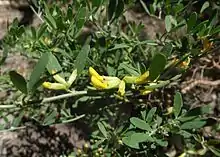Syrmatium veatchii
Syrmatium veatchii, synonyms Lotus dendroideus and Acmispon dendroideus, is a species of legume native to California.[1][2] It is known by the common name island broom.[3] It is endemic to the Channel Islands of California, where it grows on coastal bluffs and cliffs. It is a spreading perennial herb or erect shrub approaching 2 meters in height. It is hairless to hairy and gray-green in color. The branches lined with leaves each made up of a few oval leaflike leaflets up to 1.5 centimeters long each. The inflorescence bears up to 10 yellow pealike flowers, each roughly a centimeter long and fading red as they age.[2]
| Syrmatium veatchii | |
|---|---|
 | |
| Scientific classification | |
| Kingdom: | Plantae |
| Clade: | Tracheophytes |
| Clade: | Angiosperms |
| Clade: | Eudicots |
| Clade: | Rosids |
| Order: | Fabales |
| Family: | Fabaceae |
| Genus: | Syrmatium |
| Species: | S. veatchii |
| Binomial name | |
| Syrmatium veatchii | |
| Synonyms[1][2] | |
| |
When known as Lotus dendroideus or Lotus scoparius, the species was divided into varieties, although these are not recognized by some sources.[1] The rarest, var. traskiae, the San Clemente Island broom or San Clemente Island lotus, is limited to San Clemente Island. It is treated federally as an endangered species.[4][5] In the 1990s the Navy removed goats from San Clemente Island and started a management program to benefit this species. Due to the management efforts for this species, it has increased from just 9 occurrences at the time of listing to over 150 populations consisting of over 10,000 individuals. In 2007 the US Fish & Wildlife Service recommended it be downlisted from endangered to threatened status.[6]
References
- "Syrmatium veatchii Greene", Plants of the World Online, Royal Botanic Gardens, Kew, retrieved 2018-02-05
- Brouillet, Luc (2012), Jepson Flora Project (ed.), "Acmispon dendroideus", Jepson eFlora, Regents of the University of California, retrieved 2018-02-06
- Center for Plant Conservation Archived 2009-08-19 at the Wayback Machine
- California Native Plant Society Rare Plant Profile
- USFWS. L. d. var. traskiae Five-year Review. September 2007.
